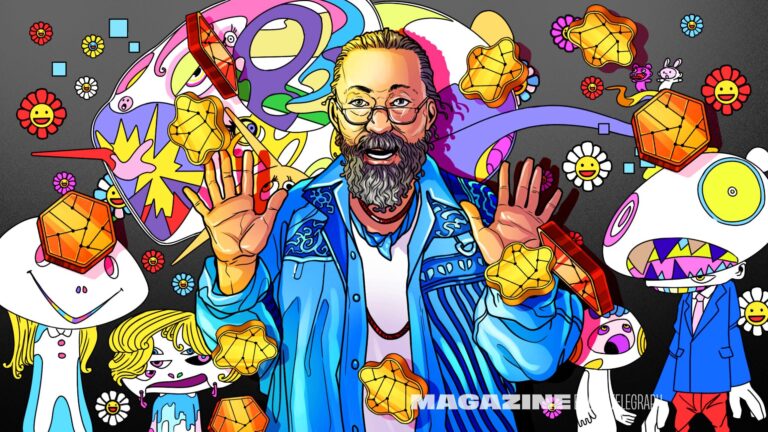
Even if you happen to aren’t personally accustomed to famed Japanese up to date artist Takashi Murakami, you have got certainly seen his work.
The pop artist’s brightly coloured signature characters have appeared on all the pieces from restricted version Louis Vuitton luggage to Supreme shirts to Vans skateboarding sneakers.
Having collaborated with celebrities like Drake, Kanye West and Billie Eilish, and establishments such because the Museum of Fashionable Artwork and Gagosian, Murakami is, indubitably, one of many greatest “standard” artists to strive their hand at making nonfungible tokens (NFTs). Regardless of this, his initiatives nonetheless haven’t blown as much as the extent of different distinguished up to date artists like Beeple.
Louis Vuitton x Takashi Murakami 2000s pre-owned monogram panda jewellery case promoting for an eye-popping $37,000 (Farfetch)
Many are satisfied that’s set to alter, claiming Murakami’s flowers are effectively on their method to turning into as iconic as CryptoPunks and Bored Apes. After a hotly anticipated however in the end disappointing NFT launch that coincided with the 2022 crypto collapse, the artist is lastly having one other go on the medium. A brand new exhibit at San Francisco’s Asian Artwork Museum reveals how Murakami creates authentic tokens from scratch.
Excessive artwork and low artwork
Whereas many take Murakami’s flowers at face value, there’s extra to them than meets the attention. Impressed by the postwar Japan wherein he grew up, these deceptively jolly icons critique the perversion and violence that underscore the nation’s otaku and kawaii subcultures.
The stylized imagery of those cultures is turning into more and more widespread in western international locations because of the export of Japanese manga, anime and video video games, and Murakami — taking a web page out of Andy Warhol’s ebook — exposes the commercialization of those mediums by the use of embracing and even exploiting them. His studio isn’t a lot a studio as it’s a full-fledged manufacturing unit, operated by 25 assistants who assist him fulfill the demand for his private model.
Unifying Murakami’s scattered oeuvre is his “Superflat” principle, which not solely refers back to the two-dimensional high quality that bridges conventional Japanese visible tradition to its up to date counterparts, but additionally to the concept that Japan, as a society, makes little distinction between “high” and “low” artwork — between the artwork you discover in a museum and the artwork you discover on billboards or the pages of a manga.
This, Murakami says, is in stark distinction to the West, the place skilled critics resolve what sort of inventive output deserves to be displayed in galleries and what doesn’t. Presently, NFTs are nonetheless largely relegated to the second group — a classification he hopes to alter.
After discovering big success with conventional media, uncontrollable occasions and poor timing conspired towards the artist’s NFT efforts. Murakami’s first flowers launched proper earlier than the downfall of FTX, inflicting their value to plummet from $260,000 to only $2,200 per token on OpenSea. Displaying a level of humility seldom seen within the worlds of each artwork and crypto, Murakami paused his gross sales and apologized to his traders.
He adopted up this apology with a prolonged assertion saying he would take a step again from the NFT market and determine easy methods to create digital artwork that matched the value of its real-world counterparts. He requested himself the sorts of questions that confuse the non-initiated. Ought to he use ERC-721 or 1155? Did he want IPFS or impartial good contracts? What about opening his personal bodily storefront?
Unfamiliar individuals
The crypto collapse left a combined impression on Murakami, who shall be exploring his frustration with the volatility of the metaverse in an exhibit he calls “Unfamiliar Folks — Swelling of Monsterized Human Ego.” Operating from Sept. 15, 2023, till Feb. 12, 2024, it largely consists of combined media items depicting humanoid monsters.
Influenced by conventional ukiyo-e woodblock prints, his acquainted kawaii fashion, and even Spanish painter Francisco Goya’s nightmarish portray “Saturn Devouring His Son” (which a younger Murakami remembers seeing on a museum journey together with his dad and mom), the distorted figures offered in Murakami’s exhibit touch upon the corroding affect of digital expertise: the relentless self-promotion on social media and the adulterating anonymity of web message boards.

His core theme — the swelling ego — not solely applies to poisonous on-line discourse but additionally to the mismanagement of media personalities like Elon Musk, Mark Zuckerberg and Sam Bankman-Fried, whose irresponsible habits has tarnished the reputations of whole industries and applied sciences.
Regardless of his destructive experiences with making and promoting NFTs, Murakami isn’t pessimistic. He believes the crypto collapse, removed from bursting an already outsized bubble, will go down in financial historical past as little greater than a short lived setback.
Learn additionally
Options
Greatest and worst international locations for crypto taxes — plus crypto tax suggestions
Options
Monero-Mining Dying Metallic Band from 2077 Warns People on Lizard Folks Extinction Scheme
“Each economically and conceptually,” he tells Journal, “the present decline of digital currencies merely marks a shaky transitional interval. Subsequently, I’m not fearful in any respect, and am nonetheless operating a number of NFT initiatives. I’ll proceed to bridge the metaverse and the true world within the artwork scene.” He thinks that “within the close to future, with the rise of younger critics and creators who perceive the idea, NFT artwork will develop into widespread .”
Standing in distinction to Murakami’s “Unfamiliar Folks” collection are numerous bodily reimaginings of his NFTs, together with painted renditions of the Murakami.Flowers. Beforehand offered at Gagosian, Murakami created these work to assist safe and stabilize the value of his NFTs, whose flooring value on OpenSea stays “as little as it may be.” A few of the work, in the meantime, have offered for upwards of $70,000.

Additionally current on the exhibit is a sculpture of the digital avatars Murakami made in collaboration with RTFKT, a digital style and collectible group recognized for its work on online game engines, blockchain authentication and augmented actuality, along with its futuristic sneaker designs.
Impressed by Snapchat’s Bitmoji, Murakami and RTFKT created over 20,000 character fashions to characterize gamers in on-line video games, every with uniquely designed eyes, mouths, garments and even behavioral traits. Murakami describes his sculpture as a “cyborg.” Not solely as a result of it has a reflective silver floor with mechanical patterns etched into it, but additionally as a result of the digital avatars on which it’s primarily based are half human and half machine.

Altering value in up to date artwork
When requested if making NFT artwork is in any approach completely different from making “conventional” artwork, Murakami answered: sure and no.
“Up to date artwork since Marcel Duchamp has clearly been a world of transcendental conceptual artwork,” he says, “so I believed that an understanding of the metaverse would come considerably naturally for the followers of up to date artwork. I immediately understood and entered into that worldview, however to my shock, others didn’t observe. I feel the massive deterrent has been a sure incapability to alter the value system of the up to date artwork world, and a ensuing unwillingness to know NFTs. Proper now, these two phrases are nonetheless fully separated.”
For the time being, most western critics don’t see NFT artwork as artwork. They suppose the imagery is “poorly executed and infantile,” and demand “the idea of the metaverse is a fraud,” in accordance with Murakami. Their aversion to NFTs — fueled partially by self-preservation — is so fervent that they reject Murakami’s tokens while celebrating their painted equivalents. Little question, the swollen egos of “Unfamiliar Folks” include traces of those people as effectively.
Maybe the western artwork world ought to be extra like Japan’s. There, the destruction of the Second World Struggle and subsequent occupation by the U.S. military fully dismantled the nation’s conventional social construction. Consequently, says Murakami, Japan discovered itself “in a really distinctive scenario the place ‘high’ artwork couldn’t be established” since there have been no elites to assert it as theirs and theirs alone. He provides:
“In Japan there is no such thing as a distinction between high artwork and low artwork, and we’re certain by the obsession that high artwork should even be dragged all the way down to the realm of the low and be gratifying to everybody.”
This, paired with the “demand for iconography paying homage to Japanese manga and anime,” signifies that Japan ought to have a wealthy and vibrant NFT market. Nonetheless, this isn’t the case. Based on Murakami, loads of Japanese artists — particularly manga artists — are all for making the change, however are prevented from doing so by strict rules that make such ventures unprofitable.
“The digital forex ecosystem the Japanese authorities has thought up,” he explains, “is so difficult and destructive that the manga or anime creators wouldn’t be enticed to depart their regular financial sphere. Subsequently, there was no signal of the NFT market growing in any respect right here.”
The scenario isn’t significantly better in America — a minimum of, not proper now. Though the crypto world is step by step selecting itself up from the FTX fiasco, NFTs are but to get better.
After hitting their peak value in January 2022, many tokens plummeted. By September of that yr, volumes had all however disappeared and demand had vanished. Murakami’s flowers aren’t the one NFTs elevate their flooring value; BoredApes and CryptoPunks are in the identical boat.
The present scenario is so unhealthy that many NFT creators don’t know what to do or the place to go subsequent. Murakami is the uncommon exception, however maybe that’s as a result of — as a famend artist — his supply of standing and earnings isn’t solely tied to tokens. For him, creating NFTs is a creative experiment as a lot as it’s an act of embracing what he (and plenty of others) nonetheless consider to be the way forward for each creativity and commerce.
And Murakami actually does consider that. Years after developing together with his concept of Superflat, he argues that the digitization of artwork has not simply verified his principle, however taken it to its logical conclusion:
“I consider the period of Superflat has come to an finish, a minimum of for the time being, together with the pandemic. The reason being as a result of the total perfection of the web-based society has now been achieved. In different phrases, the true Superflat society has now develop into a actuality. And with the rise of the metaverse, unknown zones have emerged that may add much more depth to that definitively flattened society; let’s imagine we at the moment are heading for a hyper-Superflat world.”
Subscribe
Essentially the most participating reads in blockchain. Delivered as soon as a
week.
